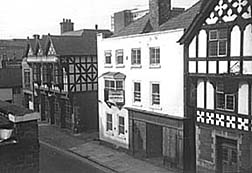  ong
establised
in
Northgate
Street,
the Northgate
Brewery produced
its
last
pint
in
1969
and
was
replaced
two
years
later
by
the
imposing
and
aesthetically
inappropriate Centurion
House which
now
dominates
this
part
of
a
street
that
otherwise
has
survived
relatively
unchanged.
It formerly housed
Cheshire's
County
Court until this moved to a new home in 2001- a brand new building sitting, unbelievably, on top of part of Chester's Roman Amphitheatre! ong
establised
in
Northgate
Street,
the Northgate
Brewery produced
its
last
pint
in
1969
and
was
replaced
two
years
later
by
the
imposing
and
aesthetically
inappropriate Centurion
House which
now
dominates
this
part
of
a
street
that
otherwise
has
survived
relatively
unchanged.
It formerly housed
Cheshire's
County
Court until this moved to a new home in 2001- a brand new building sitting, unbelievably, on top of part of Chester's Roman Amphitheatre!
Our
photograph
shows
the
street
before
the
coming
of
Centurion
House,
when
this
part
of
the
site
was
occupied
by
the Northgate
Wine
Stores and
the
entrance
to
the
old
brewery
was
just
beyond
it.
On its site once stood the Golden Falcon Inn, at one time one of Chester's leading coaching inns and where, in 1741, the composer George Friderick Handel stayed. You
can
see
another
photograph
of
the
Northgate
Brewery,
as
seen
from
the
City
Walls, and read more about it and the old Falcon here (and to learn much more about the vanished inns of Northgate Street and the rest of Chester, go here).
On the subject of coaching inns, aside from the Golden Falcon, the other Chester establishments that were involved in this trade were The White Lion, where the Forum entrance is now, The Pied Bull, of which more shortly, The Coach & Horses- now The Coach House in the square and The Feathers on the corner of Foregate Street and Love Street. Goods traffic in those old days was operated by a system of pack horse trains which could be seen along nearby Upper Northgate Street and Liverpool Road, waiting to be hired and loaded.
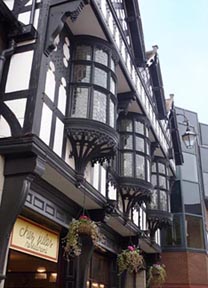 The
attractive
oriel-windowed timber
building
to
the
left
of
the
old
wine
stores
was
erected
in
1911
as
a fire
station-
surely
one
of
the
most
picturesque
in
the
country-
designed
by James
Strong,
a
pupil
of
John
Douglas.
It
closed
in
1970
when
a
new
fire
station
was
opened
on
St.
Anne
Street,
next
to
the
Northgate
Arena.
It
served
for a
while
as
retail
premises,
but
has
since
been
transformed
into a
smart French
restaurant. The
attractive
oriel-windowed timber
building
to
the
left
of
the
old
wine
stores
was
erected
in
1911
as
a fire
station-
surely
one
of
the
most
picturesque
in
the
country-
designed
by James
Strong,
a
pupil
of
John
Douglas.
It
closed
in
1970
when
a
new
fire
station
was
opened
on
St.
Anne
Street,
next
to
the
Northgate
Arena.
It
served
for a
while
as
retail
premises,
but
has
since
been
transformed
into a
smart French
restaurant.
On
the
right
of
the
photograph
may
be
seen
the Liverpool
Arms on
the
corner
of
Water
Tower
Street,
standing
today
much
as
it
did
when
the
Northgate
brewery
next
door
supplied
its
beer-
although
its
external
appearance
has
since
been
much
altered-
compare
with this
photograph of
the
Northgate
a
century
ago
where
the
Liverpool
Arms,
minus
its
'black-and-white'
panelling,
may
be
seen
on
the
extreme
left.
The
pub
was
formerly
known
by
a
variety
of
other
names: in 1822 it was The Liverpool Tavern, licencee William Towers, at other times over the years The Dog
and
Partridge, The Bull
and
Dog and,
in
1789, The Loggerheads
Tavern- the
sign
at
this
time
depicted
two
stupid-looking
clowns,
with
underneath
the
motto
"We
three
loggerheads
be"-
the
spectator,
of
course,
counting
as
one
of
the
three!
Travellers along the road between the North Wales towns of Mold and Ruthin- and visitors to the splendid country park there- will have observed a hostelry also called the Loggerheads Tavern- complete with a sign bearing a painting of those two 'loggerheads'! In fact, the entire neighbourhood bears the name of Loggerheads. Does anybody know if there is a connection between the old Chester establishment and the contemporary Welsh one?
The restaurant directly
across
the
road
was
formerly
another
pub, The Grosvenor
Arms.
You can see an old photograph of it in our Lost Pubs of Chester pages.
An
earlier,
timber-built
tavern
stood
on
the
same
spot
in
the
18th
century
known
as The Hen
and
Chickens which
is
said
to
"have
reaped
golden
harvests
when,
in
the
days
of
the
old Northgate
Prison,
unfortunate
malefactors
suffered,
close
to
this
spot,
the
last
penalty
of
the
law
at
the
hands
of
the
public
hangman"
(Hughes
1858).
This
entire
block
of
old
shops
narrowly
escaped
demolition
in
1973
when
the
Dean
and
Chapter
of
the Cathedral had
the
bright
idea
of
erecting
a five-storey
office
block on
the
site and
a housing
development behind it.
This
was
thankfully
abandoned
when
the
discovery
of
substantial
Roman
remains
on Abbey
Green led
to
the
entire
area
being
scheduled
as
an
Ancient
Monument
and
severe
restrictions
placed
upon
new
developments.
The
production
and
consumption
of
strong
drink
has
long
been
enjoyed
in
Chester.
We know little concerning the drinking places of the Roman occupants of the
fortress of Deva Victrix, but much, perhaps, may be inferred from the Roman city of Pompeii, where there were said to be 900 bars (thermopolium)
and taverns (tabernae) to serve a population of a few thousand- in addition to the seamen, travellers
and traders of the port. Many of these establishments have been wonderfully preserved, down
to the drinking vessels (sometimes chained to the bar to deter theft) and grafitti scratched
upon their walls.
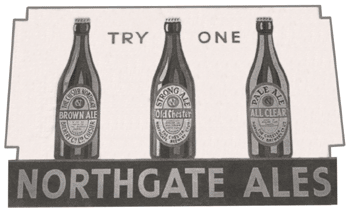 Granted, Pompeii was an affluent, settled civilian town at the heart of the Empire whereas Deva was a frontier military
fortress, but we do know that considerable quantities of wine were brought
here from the continent and that the legions also became increasingly fond of a brew that had long been produced on these islands, cervese (beer). Accounts dating from AD 90-130 found at the fort of Vindolanda on Hadrian's Wall show that considerable quantities of the stuff was purchased from local producers and one such, Atrectus Cervesarius ('Atrectus the Brewer') is the first named maker of beer in British history. And there seems little reason to doubt that others just like him
played their part in satisfying the thirsts of the thousands of soldiers, sailors, merchants
and others here in the great fortress of Deva. Granted, Pompeii was an affluent, settled civilian town at the heart of the Empire whereas Deva was a frontier military
fortress, but we do know that considerable quantities of wine were brought
here from the continent and that the legions also became increasingly fond of a brew that had long been produced on these islands, cervese (beer). Accounts dating from AD 90-130 found at the fort of Vindolanda on Hadrian's Wall show that considerable quantities of the stuff was purchased from local producers and one such, Atrectus Cervesarius ('Atrectus the Brewer') is the first named maker of beer in British history. And there seems little reason to doubt that others just like him
played their part in satisfying the thirsts of the thousands of soldiers, sailors, merchants
and others here in the great fortress of Deva.
Before
the
Roman
came
to
Rye
or
out
to
Chester
strode
The
rolling
English
drunkard
made
the
rolling
English
road
The
drinking
establishments
of
Saxon
Chester
are
an
equal
mystery
to
us;
as
the Chester historian Thomas
Hughes wrote,
"The
Anglo-Saxons
had
their eala-hus (ale
house), win-hus (wine
house)
and cumen-hus (inn)
but
there
are
no
records
of
their
whereabouts".
We
do
know,
however,
that
a
variety
of
weak
beer
was
the
staple
drink
of
the
entire
population,
being
considered
safer
than
water,
and
the
law
stated
that
anyone
brewing
or
selling
bad
ale
would
have
to
pay
a
fine
of
four
shillings,
or
be
forced
to
"sit
in
a
chair
full
of
dung". This is probably a reference to some sort of 'ducking stool'
in which the unfortunate offender was immersed into a pond or other body of filthy water. Whatever the case, modern
brewers
beware!
A
millennium
later,
the Chester
Directory for
the
year
1792
records
around
140
inns
in
the
town,
and
by
1858 the number had greatly increased,
Hughes
recorded
36
operating
in
Northgate
Street
alone,
and
several
considered
ancient
then
continue
to
flourish
today.
There is a much-repeated local tale that Chester once boasted 365 pubs- one for each day of the year. This writer remains to be convinced that this was ever actually the case- at the same time at least- but here is a list of the huge number that actually did exist (aside from those that continue to exist) in the small town. You
can
also
read
the
reminiscences
of
a
'frequenter'
of
one
of
the
most
remarkable
of
them,
the
extraordinary King's
Arms
Kitchen.
There
is
a
facsimile
of
an
old
notice
board
outside the venerable Pied
Bull
Inn (left),
a
former
coaching
inn, showing
the
miles
to
various
distant
locations:
London
198,
Worcester
85,
Ludlow
68,
Bristol
180
and
Bath
185
miles.
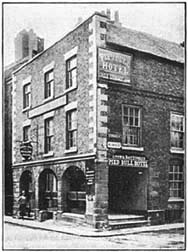 The
first
four-horse
coach
service
to
Birkenhead
and
the
ferry
to Liverpool started
from
here
in
1784,
operated
by
one
John
Paul.
Five
years
later,
the
stables
at
the
rear
of
the
inn
were
destroyed in a disastrous fire. This was reported in Adams’s Weekly Courant, 20th January 1789, as follows: The
first
four-horse
coach
service
to
Birkenhead
and
the
ferry
to Liverpool started
from
here
in
1784,
operated
by
one
John
Paul.
Five
years
later,
the
stables
at
the
rear
of
the
inn
were
destroyed in a disastrous fire. This was reported in Adams’s Weekly Courant, 20th January 1789, as follows:
"On Tuesday Evening last, about six o’Clock, a Fire was discovered in a Stable belonging to the Py’d-bull Inn, Northgate-street, in this City, which raged with increasing Fury, for near three Hours, till by the active Exertions of the Populace, the Flames were prevented from communicating to the adjoining Buildings. The Horses were providentially got out uninjured; but the most shocking Circumstance attending this Accident, is, the Loss of the Life of the Ostler: This unfortunate Man, it is believed, fell a Sacrifice to his own Carelessness, by taking a lighted Candle into the Hay-loft, whilst in a State of Intoxication, and falling asleep, the sad Consequences necessarily followed. The Groans of the dying Man were very sensibly heard, a considerable Time before his Dissolution, and no Assistance could possibly be given him. The Remains of his Body were found among the Hay, in a State too shocking to be described. Mr. John Dennil, the Proprietor of the Premises, returns his sincere Thanks to the Gentlemen and others, for their active and vigilant Assistance in extinguishing the Flames, and preventing the Conflagration from spreading further, and also for the plentiful Supply of Water so generously afforded".
The
Pied
Bull
is
now
the
oldest
licenced
house
in
Chester
still
serving
beer.
The
land
where
it
stands
had
originally
been
given
by
Richard
the
Butler
around
1155
to
the Nuns
of
St. Mary's upon
the
occasion
of
his
mother,
Gunnora,
taking
the
veil
and
dwelling
houses
were
erected.
In
1267,
Roger
the
Barber
was
granted
a
house
here, "on
the
site
of Le
Lorimersrowe" (a
lorimer
was
a
maker
of
spurs)
and
by
1533
it
seems
to
have
been
rebuilt
and
had
become
the
home
of
the
Recorder
of
Chester,
and
known
as Bull
Mansion.
Within
20
years,
however,
it
had
become
an
inn,
Richard
Grimsditch
being
the
first
publican
mentioned
in
the
Innkeeper's
Accounts
of
1571.
(The
presence
of
the
long-established
nearby
Cattle
Market-
which survived until
the
counstruction
of
the Inner
Ring
Road in
the
1960s-
led
to
a
proliferation
of
associated
pub
names
in
the
neighbourhood-
the White
Bull a
few
doors
away,
the Bull's
Head down
the
street,
the
still-extant Bull
and
Stirrup outside
the
Northgate
and
the Brown
Cow opposite
that,
as
well
as
the Bull
and
Dog-
now
called
the Liverpool
Arms,
which
we
visited
earlier).
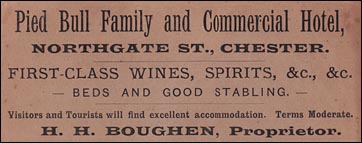 Much
of
the
Pied Bull
was
again
rebuilt
in
the
17th
century
and
the
present
overhanging
front
was
added
during
the
18th.
The
interior
retains
many
antique
features:
the
fine oak
staircase
survives
from
the
old
mansion
of
1533
and
an
interesting
17th
century
painted
coat
of
arms
is preserved
above
the
fireplace. At
various
times
in
the
past,
the
Pied
Bull
has
also
gone
under
the
names
of
the Bull
Inn and
the Delta
Hotel. It was listed as The Py'd Bull in Cowdroy's Directory in 1789 when the licencee was James Hartley. Much
of
the
Pied Bull
was
again
rebuilt
in
the
17th
century
and
the
present
overhanging
front
was
added
during
the
18th.
The
interior
retains
many
antique
features:
the
fine oak
staircase
survives
from
the
old
mansion
of
1533
and
an
interesting
17th
century
painted
coat
of
arms
is preserved
above
the
fireplace. At
various
times
in
the
past,
the
Pied
Bull
has
also
gone
under
the
names
of
the Bull
Inn and
the Delta
Hotel. It was listed as The Py'd Bull in Cowdroy's Directory in 1789 when the licencee was James Hartley.
Beneath
the
Tudor
staircase,
some
say
they
can
feel
a
chill
presence
as
they
enter
the
cellar.
A
Coroner's
report
of
1609
records
that
one
John
Davies "casually fell
down
a
pair
of
stairs
leading
to
the
Sellar
belonging
to
the
Pied
Bull
Inn
and
with
a
knife
in
his
hand...
and
dyed".
Or
then
again,
it
may
just
be
the
cold
draught
from
the
open
cellar
grating...
In the mid-19th century, when the great days of coaching were drawing to a close, the Pied Bull was described as "a venerable hostelry, serenely triumphing over the dust of centuries, and still one of the most respectable inns of the city". Here we see an advertisment for the inn from The Visitor's Chester Guide in 1884.
An old fire bell was long displayed at the Pied Bull which once hung above the debtors' courtyard at the grim gaol which once stood where the Queen's School is now. The bell was said to have had a reputed range of ten miles and it bore an inscription under the royal arms, "Patent No. 3291- Naylor Vickers & Co., Sheffield. 1863. Cast Steel." How it came to be displyed here and what became of it afterwards is unknown.
Before
setting
out
upon
a
walking
tour
of
Wales
which
resulted
in
his
(highly
recommended)
1862
work, Wild
Wales, George
Borrow,
a
Norfolk
gentleman, who
had
taught
himself
Welsh
in
his
youth,
stayed
at
this "old
fashioned
inn", where was a Welsh chambermaid,
"with whom I soon scraped acquaintance, not, I assure the reader, for the sake
of the pretty Welsh eyes she carried in her head, but for the sake of the pretty
Welsh tongue which she carried in her mouth".
He
described
his
less-than-favourable
first
encounter
with
Chester
ale
here, "I shall find the ale bad, said I, for Chester ale has a villanous character"- by
treating
us
to
Sion Tudor's
memorable
earlier
quote:
Chester ale, Chester ale! I could ne'er get it down,
'Tis made of ground-ivy, of dirt, and of bran,
'Tis as thick as a river below a huge town!
'Tis not lap for a dog, far less drink for a man... |
You
can
read
more
of
this (including what he thought of the Cheshire cheese!)
and
of
his
other
impressions
of
our
city here. The entire, excellent, text of Wild Wales is available
to read and download here. We
should
also
reassure
you
that,
with
certain
notable
exceptions,
the
quality
of
'Chester
ale'
has
drastically
improved
since
Mr
Borrow
last
sampled
it! In common with many of Chester's old inns, the Pied Bll used to make its own ale on the premises. With the rise of specialist large breweries, such as the Northgate Brewery just along the road, this practice came to an end towards the end of the 19th century. But, in 2011, a micro brewery was re-established at the Pied Bull, the only one within the City Walls.
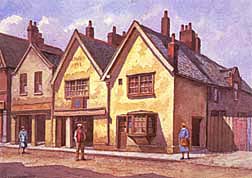 And
should
you
ever
have
the
opportunity
to
visit,
or stay at, the
old Pied
Bull,
pause
to
consider
that
thirsty
travellers
have
been
(perhaps with the exception of Mr Borrow!) enjoying
'a
pint
or
two'
on
this
very
spot
for
nearly
four-and-a-half
centuries.
Their website will tell you more... And
should
you
ever
have
the
opportunity
to
visit,
or stay at, the
old Pied
Bull,
pause
to
consider
that
thirsty
travellers
have
been
(perhaps with the exception of Mr Borrow!) enjoying
'a
pint
or
two'
on
this
very
spot
for
nearly
four-and-a-half
centuries.
Their website will tell you more...
Next
door
to
the
Pied
Bull, The Red
Lion,
establish
here
since
at
least
1600,
endured an unfortunate few years
when it was
renamed Scruffy
Murphys,
an
'Irish'
theme
bar-
before,
in
September
2001,
reverting
back
once
more
to
its
ancient
name.
A
former
landlady
of
the
old Lion assured
this writer
that
the
cellar
of
the
pub
is
definitely
haunted. (nearly all of Chester's pubs have got their ghosts- with the exception of poor Henrietta at the Blue Bell (see below)- commonly called 'George'. Well, where would you prefer to haunt?)
In February 2011, the old Red Lion was extensively refurbished and relaunched under its original name by new owners.
A
couple
of
doors
down,
in
the
last
remaining
part
of
the
vanished
12th
century Lorimer's
Row-
and
dispenser
of
refreshment
to
the
traveller
since
at
least
1494,
when
the
first
licence
to
serve
ale
was
granted,
is
the venerable Blue
Bell
Inn (right).
This
is
the
oldest
'domestic'
structure
in
Chester,
and
our
only
surviving
example
of
a
genuine
medieval
inn. The
braced
King-Post
roof
points
to
a
construction
date
for
the
present
building
of
between
1250
and
1400,
although
parts
of
the
building
may
date
from
as
early
as
the
11th
century.
The Bell may
refer
to
the
house's
proximity
to
the Abbey (now Cathedral) and
the
curfew
bell
in
the
bell-yard,
rung
every
evening
to
warn
'strangers'
to
leave
the
city
before
the
gates
were
closed
at
8pm.
The
brewhouse
which
operated
within
the
Abbey
precincts,
close
to
the
still-surviving
'Little
Gateway'
just
across
the
street,
may
well
have
supplied
the Bell with
its
beer.
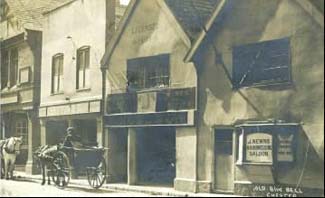 During
the
Civil
War in the 17th century,
the
underground
cellars
of
the Bell were
put
to
good
use
as
storage
for
grain
and
other
provisions,
safe
from
the
bombardment
of
the
besieger's
guns. During
the
Civil
War in the 17th century,
the
underground
cellars
of
the Bell were
put
to
good
use
as
storage
for
grain
and
other
provisions,
safe
from
the
bombardment
of
the
besieger's
guns.
Right: The venerable Blue Bell Inn photographed in 1908 and, below, in a view of Northgate Street from 1910
A
tragic
story
of
those
unsettled
times
gave
rise
to
the
legend
of
the
'Blue
Bell
ghost'.
During
the
conflict,
the Bell provided
lodgings
for
many
a
Loyalist
soldier
and
his
family.
On
the
day
of
the Battle
of
Rowton
Moor (or Rowton Heath: 24th
September
1645)
a
Cavalier
was
staying
here
with
his
lover.
He
bade
her
farewell,
saying
he
hoped
to
return
by
10
o'clock
that
evening
and
she
went
to
the
upstairs
window
to
see
her
man
going
off
to
battle.
The
news
from
Rowton
Moor
was
not
good
and
the
Loyalists
were
beaten.
Full
of
trepidation,
the
lady
awaited
his
return,
but
alas
it
was
not
to be, her
lover
had
been
killed.
Stricken
with
grief
she
staggered
down
into
the
cellar
and
committed
suicide.
Her
name
was
Henrietta,
and
it
is
said
that
to
this
day,
her
ghost
climbs
the
cellar
steps
and
walks
through
the
upstairs
restaurant
to
the
very
window
where
she
waited
for
her
lover
to
return,
all
those
years
ago...
The
unique
'cabin'
extension
at
the
front
was
erected,
"without
consent",
in
1684
by
Elizabeth
Halliwell
for
use
as
a
barber's
shop,
which
it, remarkably,
remained
until
the
1920s. During
the
18th
century,
this
extension
also
served
as
a
stage
coach
ticket
office. A small window that still may be seen high on the building was once used to sell tickets to those passengers who were sitting on top of the coach.
By
1700,
the
ancient
inn
had
become
a
house
and
shop,
but
by
1807
was an inn once more, and still bearing its ancient name.
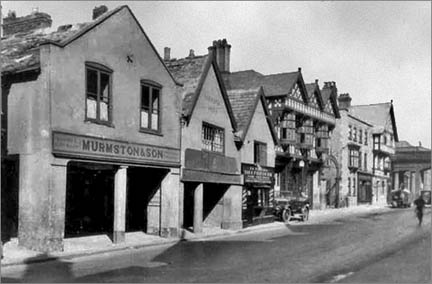 For
nearly
one
hundred
years,
from
1826,
the
Blue
Bell
was
run
by
the
Hodgson
family.
The
last
licensee
was
the
wonderfully-named Thomas
Podmore
Tushingham,
from
1924-30
(in
which
year
the
fine
picture
of
it
above
was
painted
by
Alfred
Bennet
Bamford). In the same year, 1930,
the
building
was
bought
for £1000
by
the
by the Improvement Committee of the local council,
who
planned
to
demolish
it
for
road
widening- a decision that outraged the local people. The views of a correspondent in the local press in April 1936 were typical.. For
nearly
one
hundred
years,
from
1826,
the
Blue
Bell
was
run
by
the
Hodgson
family.
The
last
licensee
was
the
wonderfully-named Thomas
Podmore
Tushingham,
from
1924-30
(in
which
year
the
fine
picture
of
it
above
was
painted
by
Alfred
Bennet
Bamford). In the same year, 1930,
the
building
was
bought
for £1000
by
the
by the Improvement Committee of the local council,
who
planned
to
demolish
it
for
road
widening- a decision that outraged the local people. The views of a correspondent in the local press in April 1936 were typical..
"A number of letters have been printed... expressing regret at the approaching demolition of the Blue Bell and its Row. It certainly is a great pity that this quaint house with its roof, which appears to be unique, in Chester at all events, is doomed, but it is only one of a series of acts which bring nearer the time when Albert Smith's "Rare Old City of Chester" may be nothing more than a memory, more utterly lost than the sturdy Roman remains which lie beneath the surface.
In the same Northgate Street a dignified eighteenth century house, and part of an adjoining one which possessed the most beautiful corniced roof in the city, have been pulled down to provide a site for a very modern cinema (the Odeon) and it seems imminent that the old coaching inn, the Pied Bull, will lose its attractive front, which already has been mutilated. In a short time, therefore, apart from the Abbey Gateways and the section of an eastern Row, Northgate Street will have qualified to compare with the dull features of an industrial town with 'up to date' aspirations. In the present case it is said that the scheme would admit of the construction of houses for firemen and the widening of Northgate Street would facilitate the the flow of traffic. Does this justify the proposal, escpecially when the increased toll of life and limb consequent on the acceleration of speed through a busy street is taken into account?"
During a council debate upon the matter, presided over by the Mayor, Alderman H W Talbott, certain interested (doubtlessly financially) parties, described the inn in terms such as "a bunion sticking out of a lady's foot", "an outstanding lump of material", "an eyesore" and "a living lie", whatever that may have meant. Inevitably, at this time when the needs of the motorist first started to outrank all other interests, the Blue bell's location was described as "a danger to traffic". One charmer addressed the outpouring of objections by deploring "this epidemic of false and sickly sentiment"..
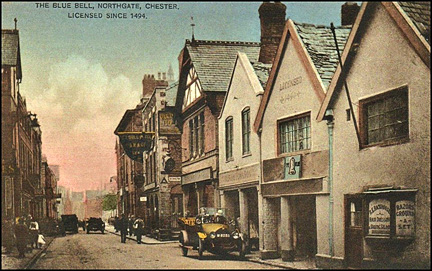 By 30 votes to 16, the council rejected a proposal to borrow £2,500 to undertake repairs and the place sat abandoned for six years, falling into serious decay, despite protests from the Chester branch of the Council for the Preservation of Rural England, the Chester Archaeological Society, and the Duke of Westminster. Eventually the Office of Works intervened, asking the council to reconsider, and pointing out that the plan to widen Northgate Street was impracticable since the Northgate itself was a Scheduled Ancient Monument. Although the council was thus prevented from destroying the Blue Bell it refused to spend money preserving it and the building remained shamefully unrepaired in 1939 but was nontheless utilised as an antique shop. By 30 votes to 16, the council rejected a proposal to borrow £2,500 to undertake repairs and the place sat abandoned for six years, falling into serious decay, despite protests from the Chester branch of the Council for the Preservation of Rural England, the Chester Archaeological Society, and the Duke of Westminster. Eventually the Office of Works intervened, asking the council to reconsider, and pointing out that the plan to widen Northgate Street was impracticable since the Northgate itself was a Scheduled Ancient Monument. Although the council was thus prevented from destroying the Blue Bell it refused to spend money preserving it and the building remained shamefully unrepaired in 1939 but was nontheless utilised as an antique shop.
Right: this old postcard features the three old inns in Northgate Street
The inn was next endangered by the 1944 Greenwood Proposals for a new Inner Ring Road, which would have see the new road follow the course of King Street and emerge through a widened Northgate, obliterating all properties along the way. This was never done, thankfully, but the revised course was equally destructive, breaking as it did through the ancient circuit of City Walls at St. Martin's Gate instead.
The
Blue
Bell
was
threatened
for a third time
in
1960, also for reasons of road widening.
There
was
even
a
serious proposal
to accept the offer of an American, who wished to
dismantle
the
entire
inn
and ship it to
the
USA!
Local
people
would, once again, have
none
of
it, and once again it miraculously survived and for the
next 22 years, still tenanted by the antique dealer and subsequently as Snow White's clothes shop. In 1984 it reverted to its ancient name and became a traditional English restaurant.
Then in early 2006, the venerable Blue Bell was transformed into East Glory, an oriental restaurant. Excellent though it was that eating and drinking should continue here after all these centuries, it seemed unforgivable that the new tenants, in their wisdom, had swept away all trace of its ancient name. We could only have hoped that poor Henrietta, the Blue Bell ghost, agreed- for how would her lost Cavalier love now be able to find his way back to her? We took the trouble to tell the story to the new occupants, who appeared to be rather distressed by the prospect of upsetting the spirits and, passing by the establishment in August 2009, were pleasantly surprised to see the name had once again changed- to that of The Blue Bell Oriental Restaurant!
In the Summer of 2011, we were even more pleased to see the Blue Bell- which is owned by Cheshire West and Chester Council- getting a smart new coat of paint and, for a short time, the old place looked better than it had in many years. A mere two years later, however, rainwater was once again gushing down the facade from broken gutters and the new paint was bubbling and peeling.
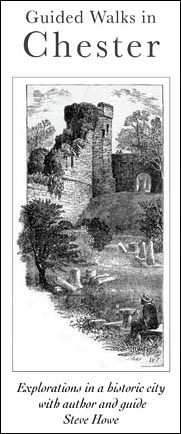 In the Summer of 2013, after eight years of trading, the Chinese restaurant closed and was soon replaced by an "international tapas" restaurant that opened in September 2013. In the Summer of 2013, after eight years of trading, the Chinese restaurant closed and was soon replaced by an "international tapas" restaurant that opened in September 2013.
The Blue Bell may have long ceased trading as an inn but the other
establishments
remain
and,
should
you
feel
the
need
this
early
on
in
our
walk,
continue
to
serve
a
fine
pint. In
addition
to
the
Pied
Bull (which did survived that threat of road widening intact and still retains its fine facade),
Northgate
Street
once had
another,
more
luxurious,
coaching
inn, The White
Lion,
which
stood
for
centuries
at
the
far
side
of
the
Market
Square,
where
the
unsightly
entrance
to The Forum is
now. Stages departed from its door to London, Ireland and all parts of the kingdom. The coming of the railway brought about the decine of the old coaching inns and, in 1856, local author and guide Thomas Hughes, who remembered the place in its heyday, recalled that it had been, "always full of the right sort of visitors, and seldom was a stall vacant in the immense stabling at the rear... Times are changed now; every dog has his day and doubtless every Lion too: at all events, our White Lion is neither so brisk nor so vigorous as he was of yore. The present worthy landlord is himself a retired whip, and as he rambles up and down through those noble rooms, once swarming with company, must often, we fear, look back gloomily upon the past".
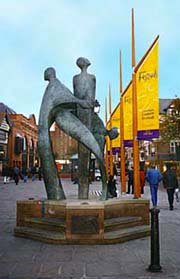 If
you
pass
through
the
ornate
stone
archway
in
the
corner
of
the
square,
between
the
ironically-entitled, and extremely ugly, Forum shopping centre and council offices and
The
Dublin
Packet
pub (this
arch
being
the
last
mocking
remnant
of
the
superb
Victorian Market
Hall which
once
stood
here)
you
will
see
through
a
glass
window
on
your
right
the
remains
of
a
rock-cut aerarium or
strongroom,
which
is
virtually
all
that survives
of
the
vast Principia, the
grand
headquarters
complex
of
the
Roman
fortress
of
Deva.
This
must
have
been
a
truly
splendid
building
and
its
colonnaded
frontage,
around
244
feet
long,
an
awe-inspiring
sight
to
the
hut-dwelling native
population.
Some
impressive
column
bases
of
the Principia's north
wing
survive
today
in
the
nearby
basement
of
a
clothes
shop
at
no
23
Northgate
Street,
and
were
open
to
public
view, albeit from above, through
a
tiny
inspection
hatch. With change of ownership, even this has now vanished.. If
you
pass
through
the
ornate
stone
archway
in
the
corner
of
the
square,
between
the
ironically-entitled, and extremely ugly, Forum shopping centre and council offices and
The
Dublin
Packet
pub (this
arch
being
the
last
mocking
remnant
of
the
superb
Victorian Market
Hall which
once
stood
here)
you
will
see
through
a
glass
window
on
your
right
the
remains
of
a
rock-cut aerarium or
strongroom,
which
is
virtually
all
that survives
of
the
vast Principia, the
grand
headquarters
complex
of
the
Roman
fortress
of
Deva.
This
must
have
been
a
truly
splendid
building
and
its
colonnaded
frontage,
around
244
feet
long,
an
awe-inspiring
sight
to
the
hut-dwelling native
population.
Some
impressive
column
bases
of
the Principia's north
wing
survive
today
in
the
nearby
basement
of
a
clothes
shop
at
no
23
Northgate
Street,
and
were
open
to
public
view, albeit from above, through
a
tiny
inspection
hatch. With change of ownership, even this has now vanished..
Bear
in
mind
that Town
Hall
Square (or Market
Square, as it is also known)
was
once
a real market
place
where
the
twice-weekly
markets
and
thrice-yearly
fairs
were
held
from
ancient
times.
(Here, for
example,
is
a
photograph
of
it
around
1900)
Today,
as
our
illustration
above
shows,
it
is
a
hodge-podge
of
concrete
flower
beds
and
amateur
sculpture.
For a while, it was also graced by
a
row
of flagpoles- also seen in the picture-
which,
amazingly,
cost
over
£42,000
and
were
described
in
the
local
press
as,
among
other
things,
'giant
hat
stands',
'gallows'
and
'dockyard
furniture'.
They
contributed
nothing
to
the
dignity
and
atmosphere
of
the
square,
but,
in
the
words
of
one
commentator,
"might
at
least
serve
to
mask
the
presence
of
the
Forum's
facade"
- not to mention
the
branch
of McDonald's which,
to
local
amazement,
was
permitted
to
open
right next
door to
the
Victorian
Gothic Town
Hall and
directly
opposite
the
west
front
of
the
medieval Cathedral. In
September
2001, however, the masts were
removed to other locations.
Before moving on, a mention must be made of a local delicacy that may bring back affectionate memories to those who grew up in Chester during the postwar years. A product of Griffith's Bakery in Northgate Street, it was sold in slices and variously known as 'Wet Nellie', 'Aunt Nellie's Wedding Cake' or 'Chester Cake'. At the start of each week, Griffith's would boil up a motley selection of the previous week's unsold cakes, add some fruit, sandwich the result between two layers of pastry and bake it. The end result was always unpredictable but its cheapness made it a local favourite, although the heavy, thick slices were also occasionally less respectfully referred to as "tram stoppers"...
• The Vanished Pubs of Northgate Street
Having digested that,
it's
time
to
take
leave
of
the
Northgate
area
and
commence
our
stroll
eastward
along
the North
Wall...
Curiosities
from
Chester's
History
no. 3
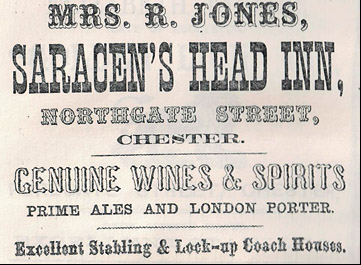 907
Ethelred
died
and Æthelflæd, the 'Lady of the Mercians', took command. She founded a burh at Chester as a defence against raids from the Danelaw and Irish Sea Vikings, extensively repaired and extended Chester's decaying Roman walls, by extending the north and east walls to the River Dee, and added new towers "placed within bowshot of each other."
Chester becomes the major power centre in the north-west of Mercia. 907
Ethelred
died
and Æthelflæd, the 'Lady of the Mercians', took command. She founded a burh at Chester as a defence against raids from the Danelaw and Irish Sea Vikings, extensively repaired and extended Chester's decaying Roman walls, by extending the north and east walls to the River Dee, and added new towers "placed within bowshot of each other."
Chester becomes the major power centre in the north-west of Mercia.
-
923
The
heads
of
Gruffydd,
Prince
of
Wales
and
Leofrid,
a
Dane,
cut
off
and
set
upon
the
gates,
after
seizing
the
city.
-
925 Athelstan (c.825-939) becomes
king
of
England -
940 Edmund
I,
(922-946) brother
of
Athelstan,
becomes
king
of
England -
946
Edmund
is
succeeded
by
his
brother Edred (reigned 946-955) -
955 Eadwig,
"the fair", also known as Edwy (941-959), son
of
Edmund,
becomes
King. -
973 King
Edgar "The
Peaceful" (943-975),
crowned
at
Bath. This event forms the basis of the present-day British coronation ceremony.
Having
reviewed
his
western
fleet,
he
came
to
Chester
attended
by
his
court.
Legend
tells
us
thay
the
King's
Palace
(or
Royal
tent)
stood
on
the
far
bank
of
the
Dee
in
a
field,
which
from
time
immemorial
has
been
known
as Edgar's
Field.
From
this
Palace
it
is
said
that
he
was
rowed
up
the
Dee
by
eight
tributary
Kings-
the
rulers
of
small
Kingdoms-
as
far
as St.
John's
Church where
they
disembarked
and
entered
the
Priory
in
order
to
swear
a
loyal
oath
to
the
King.
When
this
was
done,
they
rowed
him
back
to
his
Palace. -
-
979
Edward's short reign was brought to an end by his murder at Corfe Castle, Dorset in circumstances which are not altogether clear. Ethelred
II,
"the
Unready" (968-1016),
crowned
at
Kingston -
982
Danish
pirates
returned
to
Chester.
It
is
said
that,
when
one
was
captured
by
the
citizens,
they
beheaded
him
and,
for
amusement,
kicked
his
head
around
the
city.
It
was
said
that
this
proved
so
popular
that
it
was
repeated
whenever
a
Dane
was
captured.
First
Viking
colonies
established
in
Greenland.
-
1000 Beowulf written. Lief
Ericson,
son
of Eric
the
Red,
discovers
America
(Nova
Scotia).
Millennium
causes
widespread
fear
of
the
end
of
the
world
and
Last
Judgement. Danegeld becomes
general
tax
in
England.
Chinese
invent
gunpowder
-
1013
The
Danes
masters
of
England;
Ethelred
flees
to
Normandy.
-
-
1035
Canute
dies
and
his
kingdom
divided
between
his
three
sons: Harold "Harefoot" (1015-1040) is
given
England, Sweyn 'Forkbeard" Norway
and Harthacnut (or Hardicanute) Denmark. -
1040
Duncan
of
Scotland
murdered
by Macbeth,
who
becomes
king-
until
1057,
when
he
is
in
turn
murdered
by
Malcolm.
-
-
- 1057 During an attack upon the city by King Gruffydd (Gruffydd-ap-Llewellyn) the remains of St. Werburgh were carried onto the City Walls by the monks and were said to have "struck the king blind". A stained glass window in the cathedral commemorates this event. Leofric,
Earl
of
Mercia,
and
his
wife,
the
beautiful Lady
Godiva (997-1067) restored
the
crumbling
St.
Werburgh's
church.
- 1059 Edwin becomes the last Saxon Earl of Chester.
-
1066
Edward
the
Confessor
died
and
was succeeded
by Harold
II (1022-1066).
The
fateful year
of
the Battle
of
Hastings;
Harold
killed
in
battle
and
succeeded
by William
of Normandy "the
Conqueror" (or "the Bastard"- Guillaume le Bâtard- depending upon who's telling the story)- William I of England (1028-1087).
( a local legend
has
it
that
King
Harold
was not killed in battle,
but
fled
to
Chester
and
lived
out
his
life
as
a
hermit
on
the
banks
of
the
Dee
near St. John's
Church)
Top
of
Page | Site
Front
Door | Search the Site
Index | Chester
Walls
Stroll
Introduction
Northgate
1 | 2 | The Lost Pubs of Northgate Street | The North
Wall | About the Author
 
 You're proud to be in business in Chester so tell the world- You're proud to be in business in Chester so tell the world-
Advertise on the Chester Virtual Stroll!
Your company's logo and links directly to your website and email- click on the Eastgate Clock to learn more...
|
Strictly ©
Steve
Howe
/
B&W
Picture
Place
|

 ong
establised
in
Northgate
Street,
the Northgate
Brewery produced
its
last
pint
in
1969
and
was
replaced
two
years
later
by
the
imposing
and
aesthetically
inappropriate Centurion
House which
now
dominates
this
part
of
a
street
that
otherwise
has
survived
relatively
unchanged.
It formerly housed
Cheshire's
County
Court until this moved to a new home in 2001- a brand new building sitting, unbelievably, on top of part of Chester's Roman Amphitheatre!
ong
establised
in
Northgate
Street,
the Northgate
Brewery produced
its
last
pint
in
1969
and
was
replaced
two
years
later
by
the
imposing
and
aesthetically
inappropriate Centurion
House which
now
dominates
this
part
of
a
street
that
otherwise
has
survived
relatively
unchanged.
It formerly housed
Cheshire's
County
Court until this moved to a new home in 2001- a brand new building sitting, unbelievably, on top of part of Chester's Roman Amphitheatre!